The Galleria mall in White Plains is closing after 43 years | A Retrologist Appreciation
The Galleria wasn't just any mall, it was My Mall. This is why I'll miss it -- and here is why I hope what replaces it honors what was destroyed in the 1970s to make way for it.
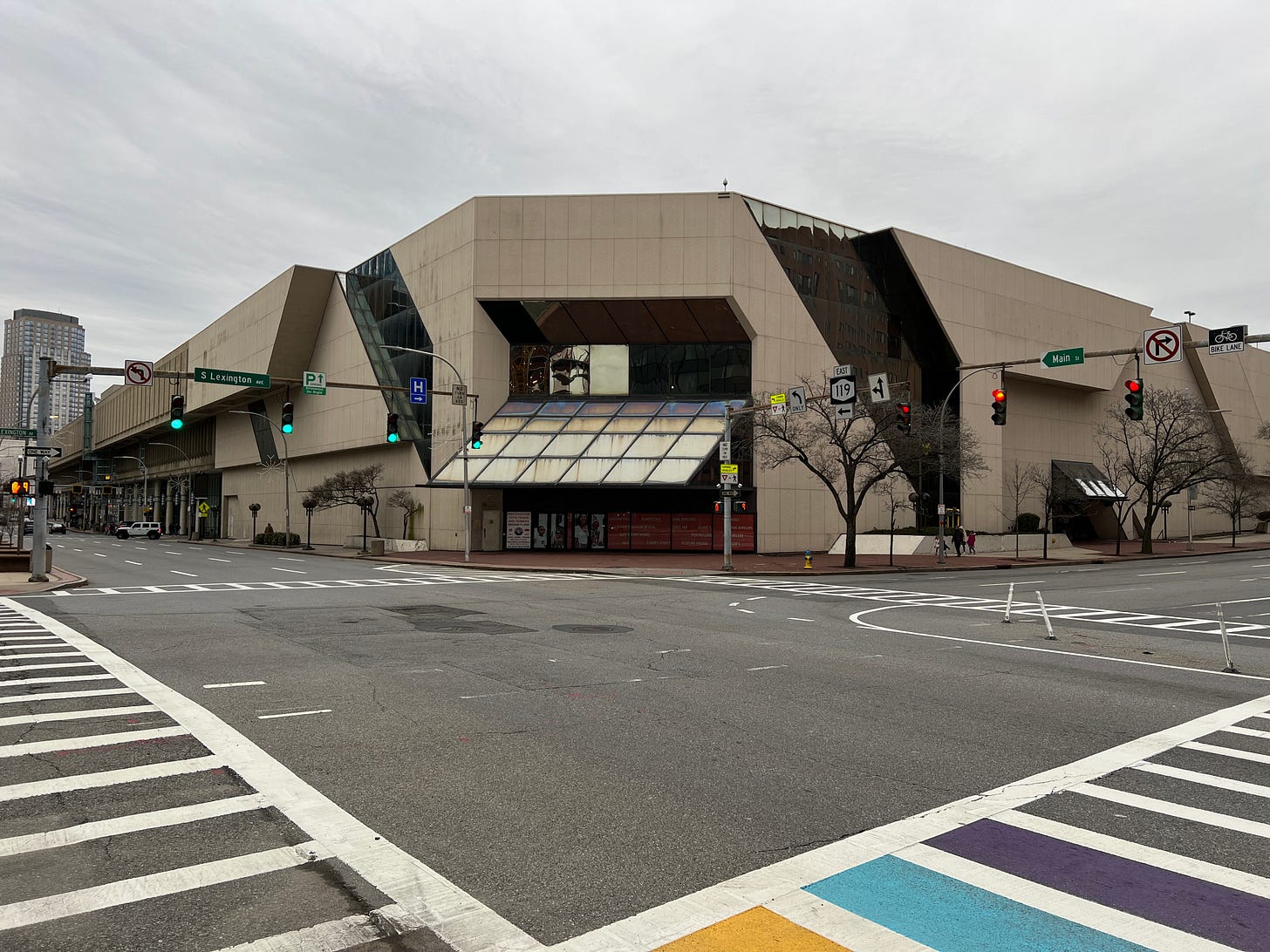
On August 6, 1980, an estimated 150,000 people jammed into the Galleria mall in White Plains, New York, just north of New York City. It was the opening day of an 865,000-square-foot behemoth in the heart of downtown: an enclosed mall encased in a Brutalist concrete bunker spanning 10 acres and two immense city blocks, even bridging a major thoroughfare.
Half a decade earlier, the Galleria existed only on a restaurant napkin sketch whipped up by Peter Leibowits, the president of the U.S. division of Cadillac Fairview, the Canadian real-estate developer.
Around the time the Galleria opened, the ambitious and visionary Leibowits, without whom the Galleria may never have been built, told Gannett’s Geoffrey Thompson that he’d like to frame that napkin, borrowed from a downtown White Plains restaurant where he was brainstorming the future of what was then a vast urban-renewal zone seen as the key to the city’s future.

I wonder whether that napkin still exists, because someday soon, it will be, in a manner of speaking, all that’s left of his Galleria
The Galleria is in its death throes, the final date of life set for March 31.
The Galleria is down to just a couple of shops out of 150 storefronts and two department-store anchors it was designed to hold. Though there were reports it would close for business on Thursday, March 23, you can still have very limited access to it. To get past aggressive security guards at the remaining open entrance on Main Street, you are best off making an appointment at the LensCrafters, which was set to close Saturday, March 25, or Westchester Trains & Hobbies, closing Friday, March 31, the mall’s reported last day. In other words, if you are considering trying to get inside, call ahead.

It’s poignant that the hobby shop will be the last in a long line of tenants to leave, for the shop is already a mall-closure refugee. The shop used to be located at the now demolished White Plains Mall nearby, a much smaller shopping center built in 1972 and demolished last year after languishing for decades, largely as a home for the Department of Motor Vehicles, a McDonald’s and hardy mom-and-pops like the hobby shop.
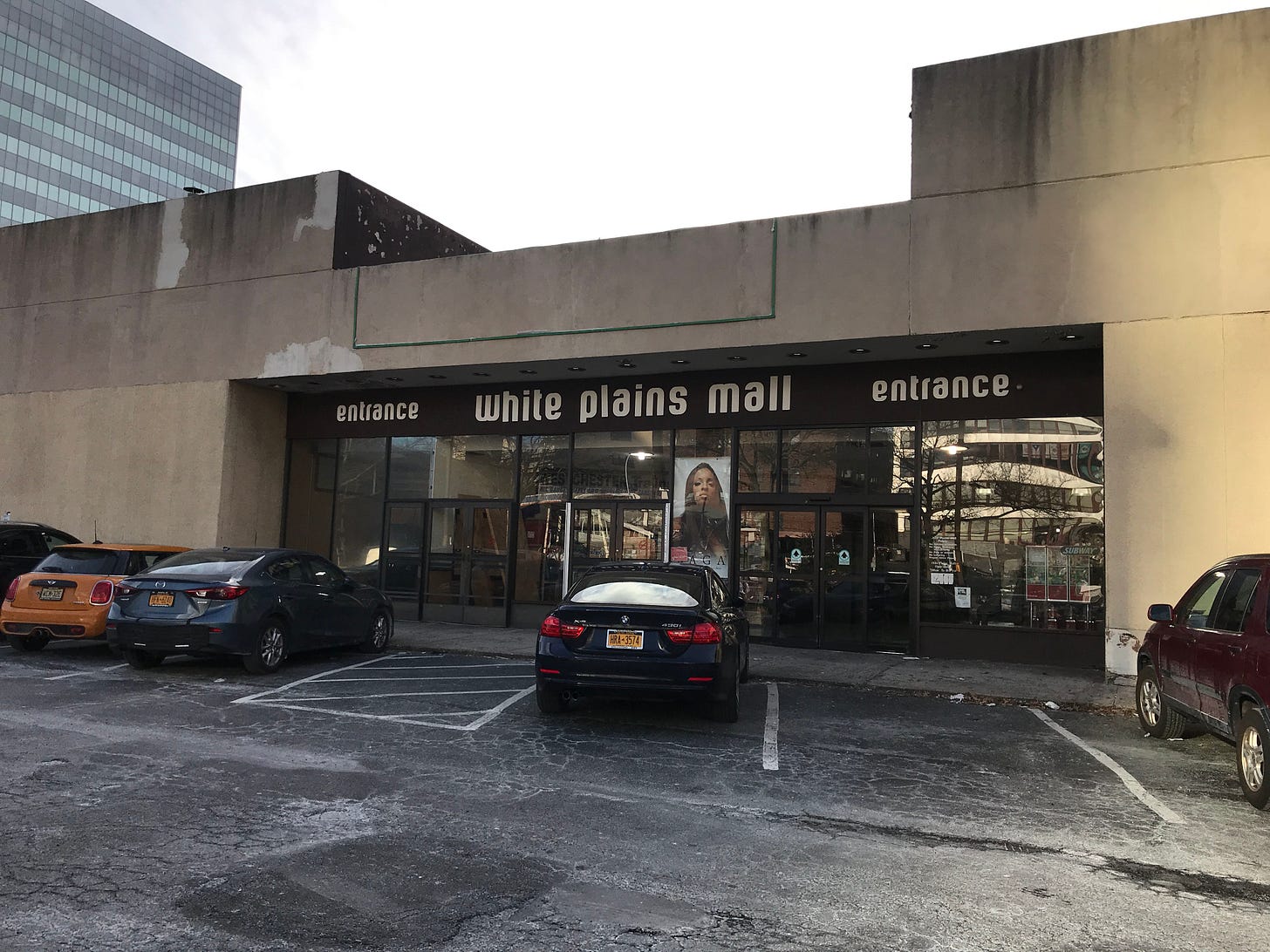

(Interestingly, some of those mom-and-shops at the White Plains Mall were themselves victims of urban renewal, moving to that mall in the 1970s from the demolished area that would eventually become the Galleria. It’s amazing to think of relocated White Plains Mall tenants moving back to the Galleria, the cause of the initial relocation.)
The Galleria opened with pomp, circumstance, and clowns mingling with eager crowds, quickly captured the zeitgeist of 1980s pop culture, and is now closing with a whimper, kind of just fading away.

Yes, it’s another mall closure in an era when news of dying and dead malls is commonplace, just as ribbon cuttings at mall grand openings were routine a generation earlier, but this one hits different, as they say, because the Galleria was My Mall, and I loved it.
In 1983, the parent company was bursting with pride over the Galleria’s growth, calling the mall its “showcase in the United States,” the local Gannett paper reported. Sales were said to be healthy, though there was debate about just how successful the mall really was. Regardless, the Galleria was hitting its 1980s stride.
Nobody knew it then, but these were to be its glory days, and within its walls awaited some of the happiest days of my youth. Leibowits declared in 1976 that the Galleria, ground not even broken yet and facing legal headwinds, would not merely serve as a shopping center, but become “a way of life,” he told the Gannett paper.
It did just that, and I lived it.
The Galleria, for 1980s adolescents like me, became the place to see and be seen. In 1982, a continent away from the White Plains Galleria, Frank Zappa and his daughter, Moon, released the song “Valley Girl,” which name-dropped another Galleria, the one in Sherman Oaks, California, in the San Fernando Valley.
While the song celebrated the social rituals of the iconic 1980s Valley Girl, it could have been just as well about the girls (and those chasing them) at the Galleria in White Plains, even if the phrases “gag me with a spoon” and “grody to the max” were not in their working vocabulary. The Gannett paper christened them, in an article about the mall anthem, “Galleria Girls.”
The original, enclosed version of the Sherman Oaks Galleria closed in 1999, never recovering from partial closures due to damage from the 1994 Northridge earthquake, among other indignities. A 1999 article about its demise observed presciently:
There are some social scientists who believe the demise of most malls is inevitable, thanks to changing tastes and Internet shopping.
And that’s exactly what’s happened and what may have ultimately claimed My Galleria.
***
Whenever I want to have a smart conversation about retail — and 1980s Westchester County nostalgia among countless other things — I know I can call on my friend Michael J. Berne.
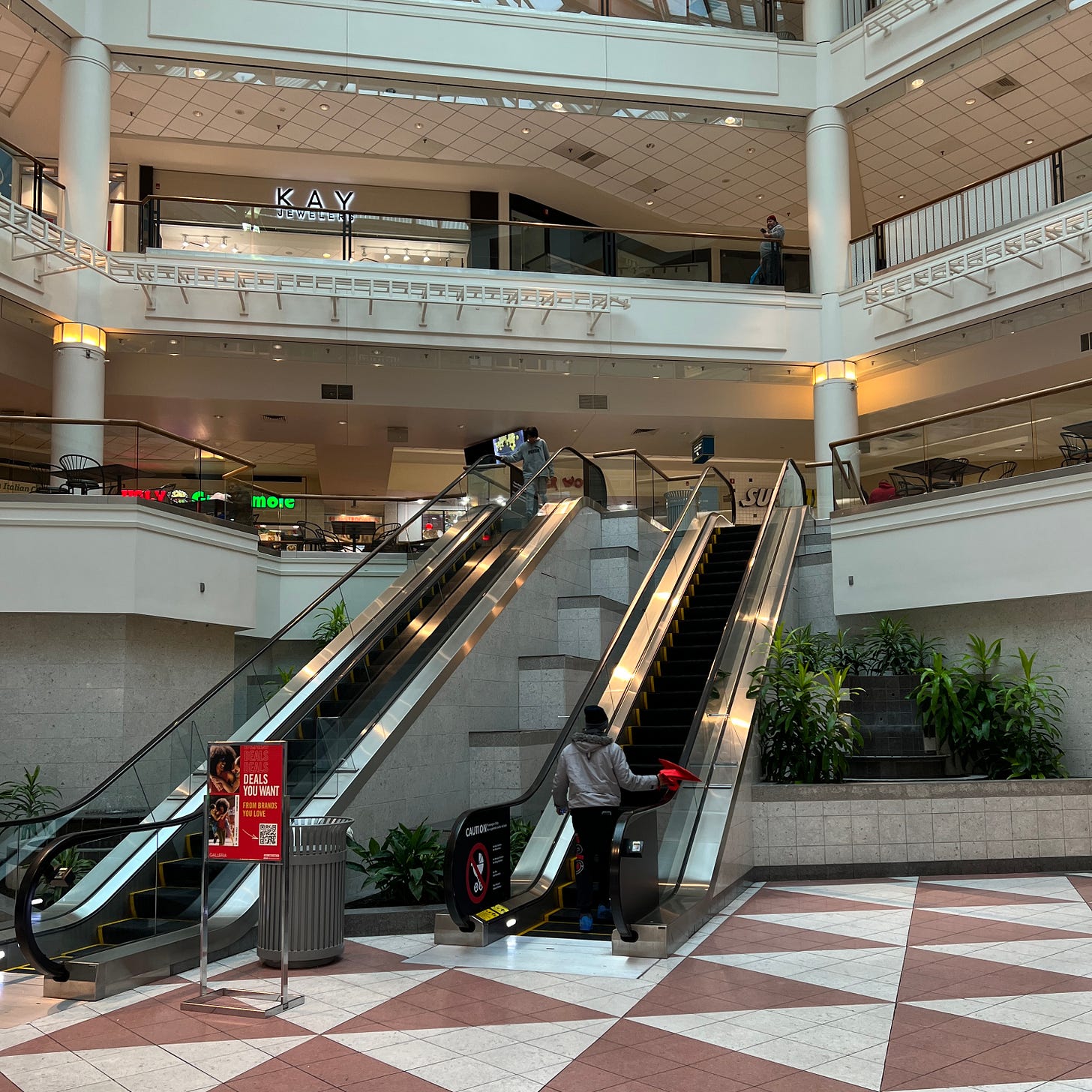
He’s the founder of urban-planning firm MJB Consulting, and I wanted to hear his personal observations on the Galleria’s demise, mainly in his role as somebody who spent much of his youth, as I did, roaming the shopping center’s Italian marble halls. He told me by email:
“The Galleria was my mall while growing up in 1980's Westchester -- I remember it like it was yesterday, the people(girl)-watching, the food court, the Mr. Green Jeans restaurant, the Software Etc. store ("Computers! Gee whiz!), the Herman's Sporting Goods, all of it. And even in my adult career as a retail planning and real estate consultant, when I know better, I would still extoll its virtues to any young punks (i.e. enlightened planners) who would scorn its fortress design and dismiss its suburban tackiness. Before the rise of coffeehouse culture and the rediscovery of the urban lifestyle, before Friends and Central Perk, it was my third place, god dammit -- and no one will ever convince me otherwise."
Well said, Mike!
Now I’m really getting worked up, for the Galleria was truly at the nexus of late 20th-century American mall culture, and Mike and I had a front-row seat, not realizing how special it was, and how fleeting it would be.
Mike mentioned so many of those defunct stores, and goodness do I remember and miss them all. It was here that I shopped for LPs and later CDs at Musicland and Sam Goody and where I bought colorful jelly bracelets at For Lovers Only, sort of like Spencer’s, with an outpost of the latter surviving here until recently. Most of the posters on my bedroom wall between 1983 and 1991 came from the Galleria.
The food court on a Saturday afternoon in 1985 was a place of wonder, where the French fries were secondary to the sport of people watching while bathing in the atrium’s filtered natural light and staring at the John Portmanesque spaceship elevator rocketing fellow shoppers among the four floors. It was a wonderful place to daydream between rounds of stimulating the economy with the parental credit card.

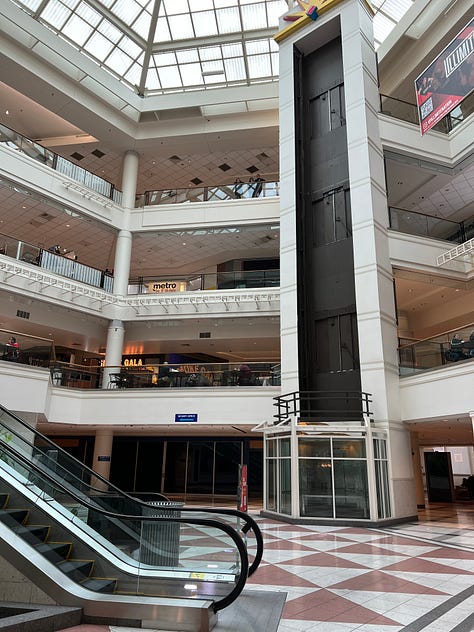
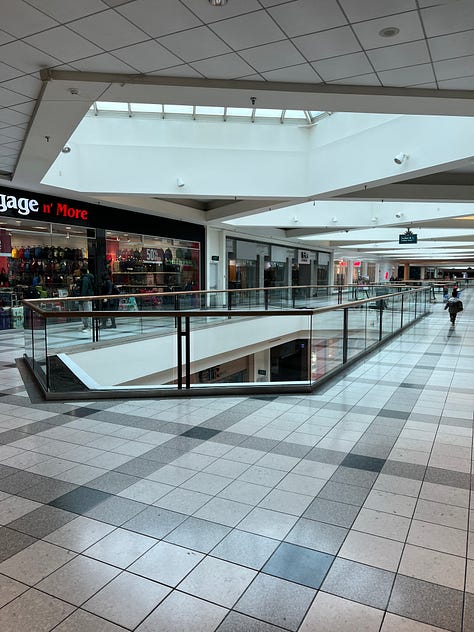


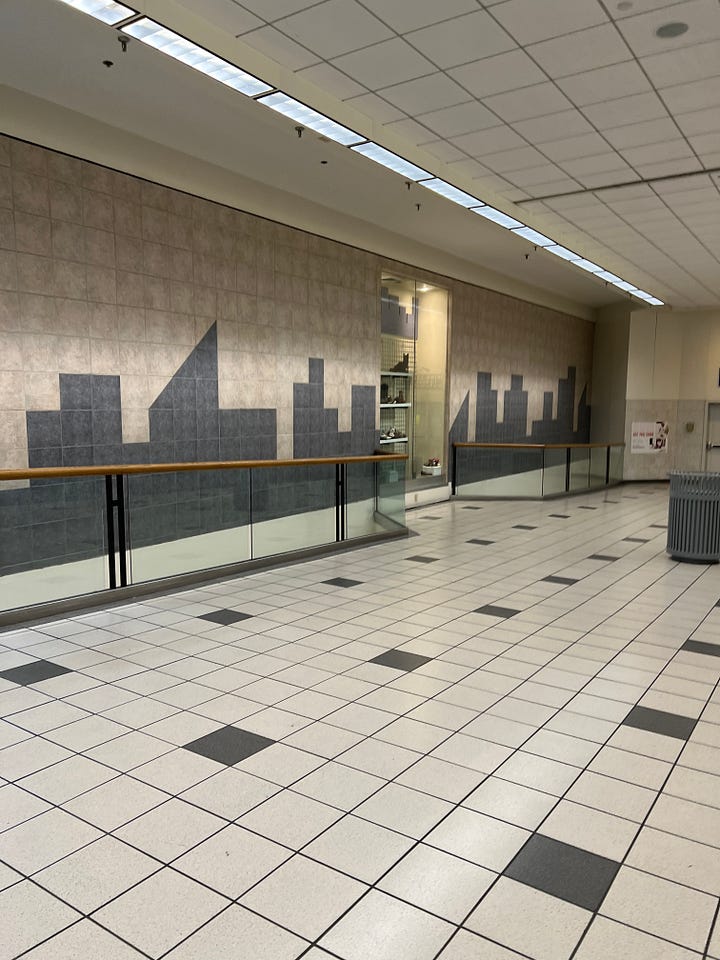
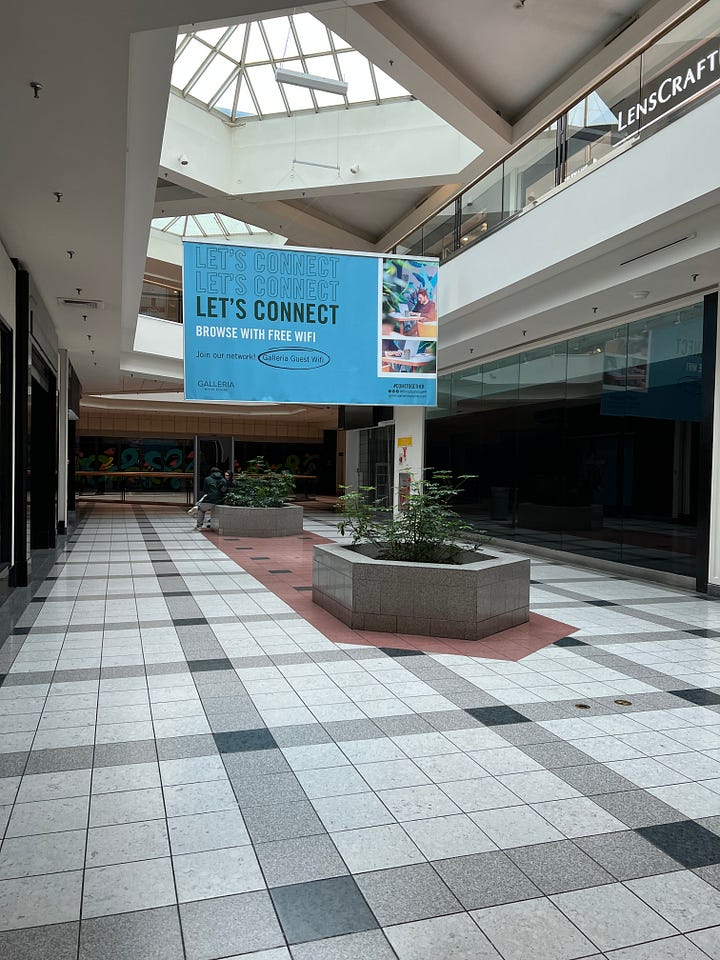
This past January, that elevator was still there, but now forever stilled, and the crowds were down to a trickle. Daydreaming was replaced with nostalgic reverie. On that day, my pal Rob Yasinsac and I paid a farewell visit, a tour that was sentimental and sad. (See his post here.)
The place was down to a dozen or so stores, and the food court had more court than food, but we sat there and had a snack, for old-time’s sake, looking up and around — and back in time.
Rob, with my friend Thomas Rinaldi, co-authored the book “Hudson Valley Ruins: Forgotten Landmarks of an American Landscape,” published in 2006. Now, 17 years later, the definition of a Hudson Valley ruin was expanded to include a place so very near and dear to our hearts, not a crumbling mansion from a time we never experienced, but our dear Galleria, a central stage of our adolescent wanderings.

As we explored the mall, artfully dodging photography-hostile security guards, we found relics of the old Sears, the sign still at an otherwise sealed parking-garage entrance to the shuttered anchor store, originally home to J.C. Penney until June 2001.
At the hobby shop, we admired a relic that most people, even the store’s operator, missed. On the floor by the front door, partially covered by a rug, were the words SAM GOODY.
This was holy ground, where Goody “Got It,” as the slogan went, or I guess these days, “Had It.”
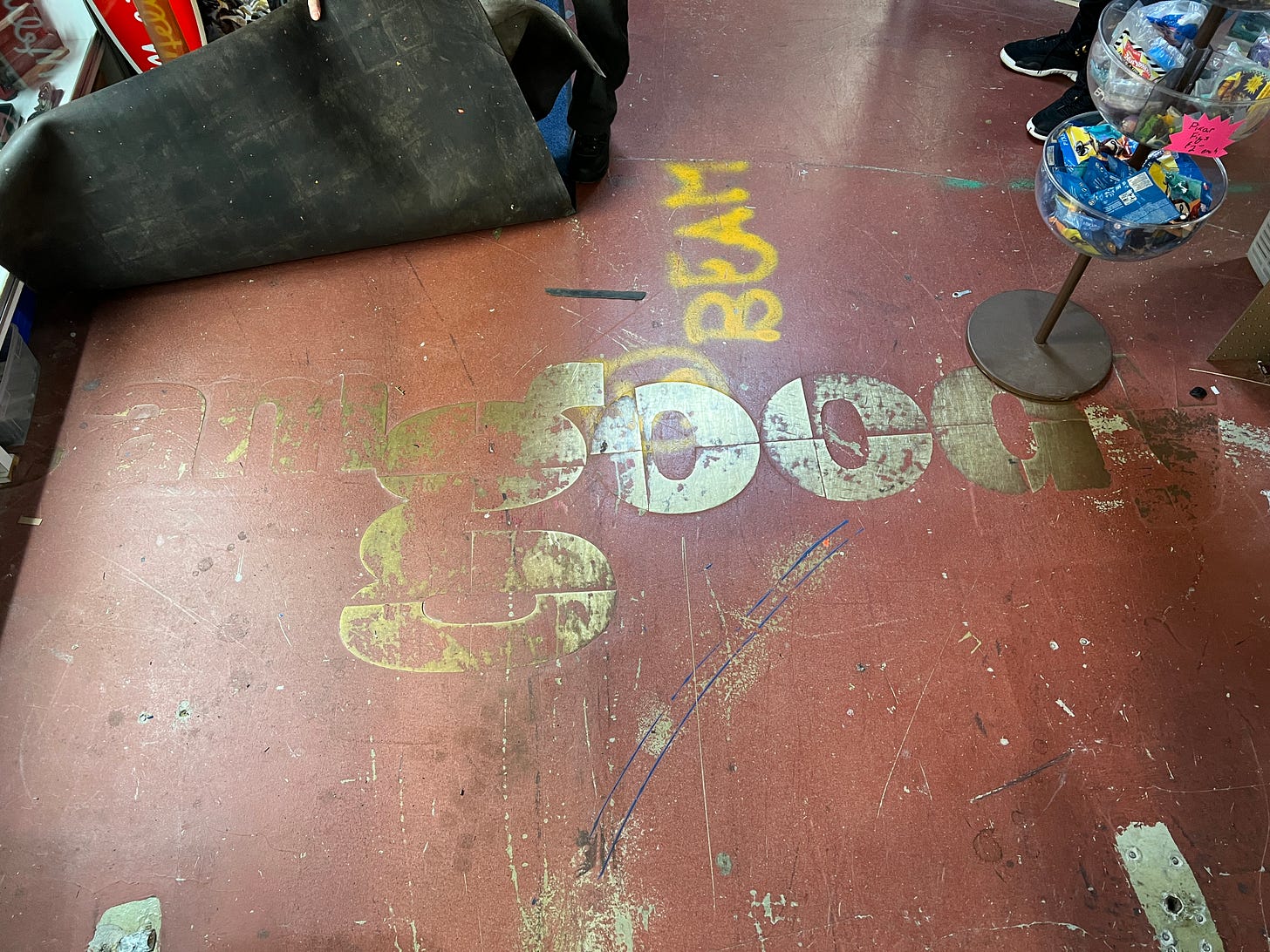
***
It’s amazing to see these relics and realize the Galleria itself is the biggest relic, but it makes sense why the mall was built here in the first place.
By 1960, White Plains was determined to revitalize its downtown, and back then, urban renewal was carried out with an army of bulldozers, and displacement of shops and residents, with bold Robert Moses-style plans that would, it was hoped, dramatically solve all problems.
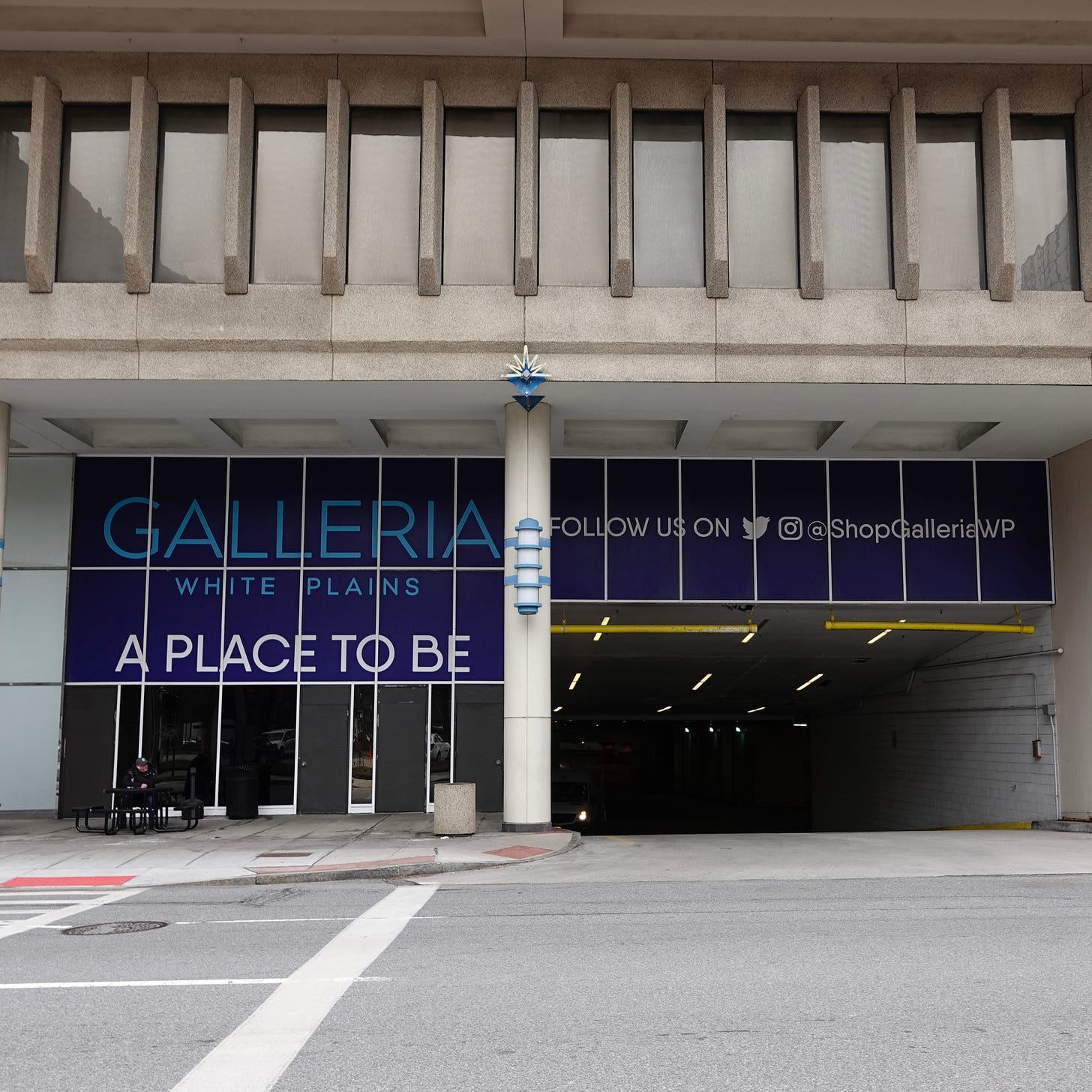
White Plains, then and now, is blessed with location, location, location. It sits in a Goldilocks spot north of New York City, and has easy highway and local road access. White Plains rests in the middle of a vast regional, economically diverse populace with plenty of affluence — and many people aspiring to it. In the Post-War years, long before the Internet and flush with economic exuberance, people were ready to shop.
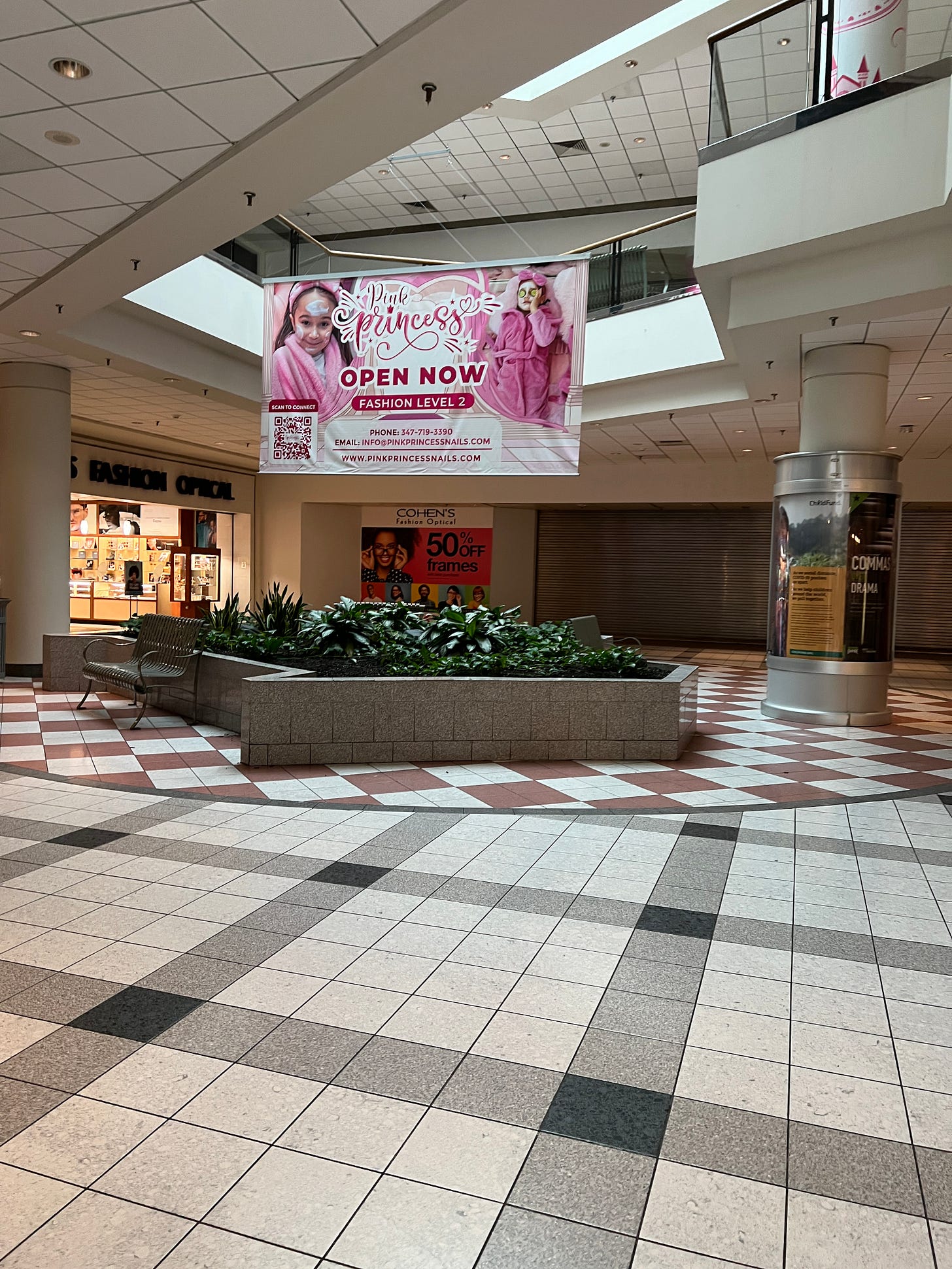
White Plains was already nicknamed the “City of a Thousand Stores” long before the Galleria added 152 more to it. The first Westchester County outlet of a major New York City department store, B. Altman’s, opened in White Plains in the early 1930s, and many more soon followed. Downtown streets were teeming with shops of all imagining, and the city catered to the car from the earliest days, smartly forming a parking authority to ensure motorists could easily park — and shop.
The original White Plains Macy’s, built in 1949, was on Mamaroneck Avenue in its own stunning, curved-facade and sadly long-ago-demolished building, and Sears, until joining the Galleria, was around the corner in what was heralded as the largest Sears east of the Mississippi River when it opened in May 1968.
In the 1970s, as plans for what was originally called the White Plains Fashion Plaza were forming, enclosed malls were usually placed in suburban locales, not in urban downtowns. The Galleria would famously buck that trend.
Gannett’s Thompson, in early 1981, declared it “the first and possibly the last large-scale urban-center style shopping mall in Westchester.”
But the Galleria would not be “the last” of its kind here — in March 1995, for instance, the upscale The Westchester opened across town, with refined anchors like Nordstrom, then a novelty in the New York area. Motorists then and now could exit the Cross-Westchester Expressway, and drive straight into the mall’s parking lot, very much by design.
That mall remains fresh and vital, yet the Galleria for almost 30 more years held its own, offering a more down-to-Earth retail mix. Whatever killed the Galleria, the retail forensic pathologists won’t be able to blame The Westchester. They both managed to co-exist peacefully.
Even until a few years ago, the talk around the Galleria was about how to revive it or reposition it, not necessarily raze it. In March 2020, visitors spoke of it still as a pleasant place to shop, maybe not the place it once was, but still nice enough, according to the Journal News.
But the subsequent loss of its two anchor stores — the final two to hold those coveted spots were Macy’s and Sears — coupled with the pandemic, the endless drain of online shopping, and I suppose, the stigma that stuck to the Galleria as being hopelessly out of date and dowdy, proved too much

Even the mayor of White Plains, Thomas Roach, was no fan, describing the pedestrian experience outside the mall as a visit to “The Great Wall of Galleria”, referring to its monolithic street presence.
Finally, right before Christmas last year, the mall, long a critical patient, was reclassified as terminal. It would be the last Christmas at the Galleria, owner Pacific Retail Capital Partners decided, and the remaining stores would have to make alternate plans by March.
The Galleria was a goner.
***
From a crush of humanity in August 1980 to a ghost town in March 2023. So ends the life of the Galleria, designed to turn downtown White Plains from “after-dark ghost town to city of lights,” a reporter wrote in 1976. The mall will likely be razed and become a mixed-used development, a process that will surely take many years.
This is also the biggest opportunity to transform White Plains’ core since the Galleria itself came along. In the 1970s, leaders of White Plains poured their desperate hopes of city renewal into the imposing mall’s concrete and rebar.
Even creator Leibowits hoped, he said, that the Galleria would lift small businesses all around it, sort of like a retail version of trickle-down economics, but he already had doubts a year after it opened. Indeed, the Galleria proved not to be that kind of catalyst, and the streets around the Galleria still struggled for decades until future developments like the City Center, better integrated with the street, arrived. Things are still far from perfect.
My hope for the Galleria site resides in the past, as I look to what was there before it was a mall, before it was sacrificed on the altar of urban renewal.

Rob posted the above photo of what this stretch of Main Street looked like pre-Galleria. As you can see, the very heart of town was ripped out for the mall.
We hope we can learn from the lessons of urban renewal, and restore a stimulating streetscape, perhaps taking cues from the buildings demolished in the 1970s, like the historic Benjamin Wistar Morris-designed courthouse on the property. A failed legal battle to save it delayed the construction of the Galleria.
I hope we can preserve one aspect of the Galleria — the feeling of town square it created. Its address was 100 Main St., after all, even if it looked nothing like a Main Street. We need real places to meet and mingle, not Metaverses.
And heck, perhaps the Galleria will be back, transformed. The Sherman Oaks Galleria that I mentioned earlier, of “Valley Girl” fame, was rebuilt as an open-air mixed-use development in the early 2000s, and is still thriving.
My Galleria was a memorable gathering place — the third place, as my pal Mike said — for “Galleria Girls” and everyone else who spent what turned out to be some of the most meaningful moments of their lives here.
Goodbye, Galleria. Thanks for the memories, and the lessons.

NOTE: Thanks for reading my appreciation of the Galleria. I’d really appreciate it if you shared it, and would love if you could subscribe, and even consider becoming a paid supporter, so I can do more of this work. Thank you!





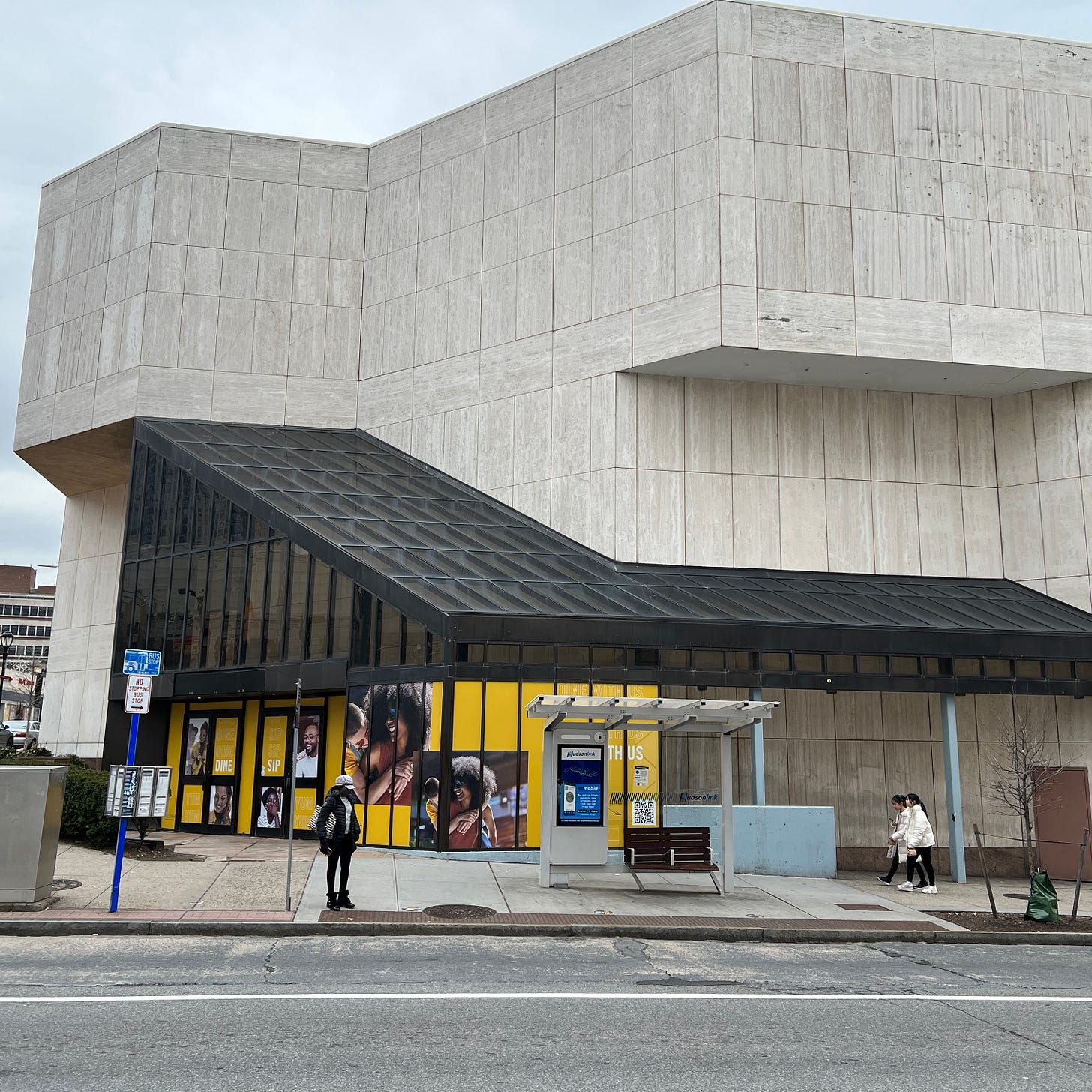




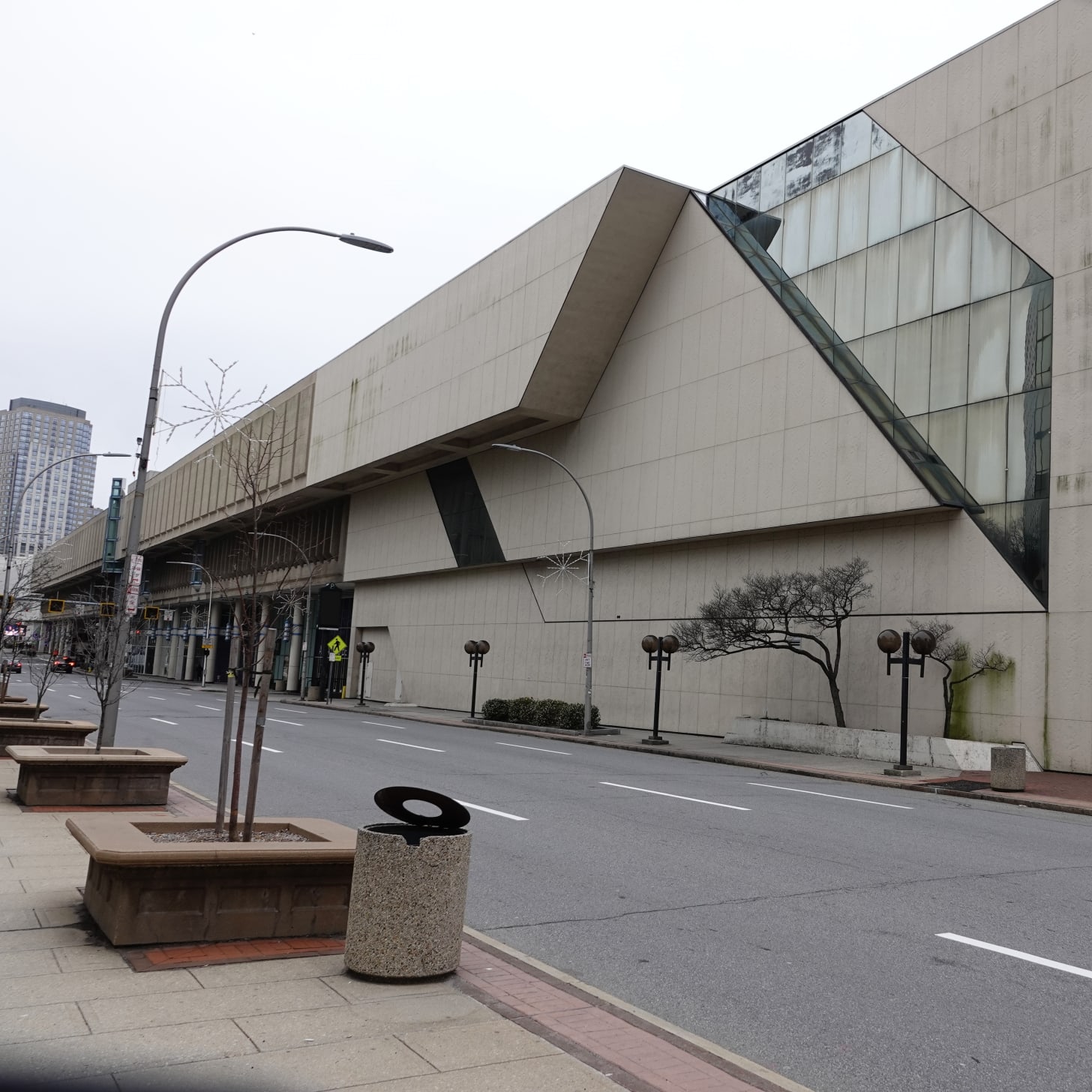






This was a beautiful piece, Rolando! Equal parts nostalgic about what the mall once was and pragmatic about what it should be in its next chapter. Good stuff!
I only spent a brief time in White Plains in 1988. I worked across the street for a spell at the Westchester Financial Center and would frequent the Galleria, mostly the food court for lunch. Thanks for the history.